Expand Your Persuasion ToolBox
Need to get people to do stuff? Then, you need persuasion techniques. You probably need a larger persuasion toolbox, full of useful tools to persuade people to do what you want them to do.
I’ve been thinking a lot lately about how people persuade each other. As a big fan of the 6 laws of persuasion video by Robert Cialdini, I can’t help but think that it’s not the whole picture. There must be more than 6. There are!
I see people often persuade someone to do something with ‘It’ll only take 5 minutes’. Using time as the key persuader, got me thinking that there must be a whole bunch of everyday persuasion techniques that people use. Which led to the need for an exhaustive list of the persuasion techniques that people use in everyday life so that we can then expand our own repertoire of persuasion techniques.
Before we get to the list of persuasion techniques and persuasion examples, let’s just bottom out the difference between persuasion and influencing…
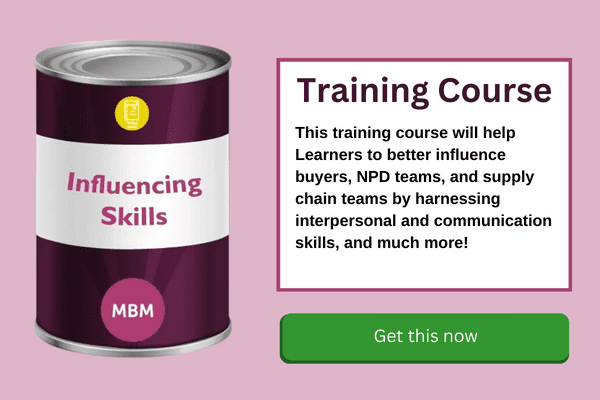
What’s the Difference Between Persuasion Techniques and Influencing Techniques?
This is a tricky topic, though ultimately not one to be concerned about because both terms can largely be used when we describe trying to change someone’s behaviour. I’d rather you and I spent our time upgrading our powers of persuasion than the semantics of which word describes it best – persuasion or influencing. If you do want to dive into the difference further, my own opinion follows:
The definition of influencing is:
The capacity to have an effect on the character, development, or behaviour of someone or something, or the effect itself.
The definition of persuasion is:
The action or process of persuading someone or of being persuaded to do or believe something.
Persuasion is often seen as negative and influencing as positive, but that’s not the case. Persuasion feels like being more direct and influencing less so.
As humans, we search Google much more for ‘persuasion techniques’ than we do ‘influencing techniques’ which might suggest that we use persuasion as the more common language for this type of thing.
Our ultimate aim is to get people to do what we want. Again, whilst it can sound manipulative this article looks at the positive use of persuasion techniques. Plus, we list those that are practical, simple and can be used every day.
In summary, I believe that persuasion is the shorter & sharper cousin of influencing. To use a metaphor, or two; Persuasion is the espresso and influencing is the latte. Or Influencing is the shotgun and persuasion is the rifle. Persuasion is a short-term change in someone’s mind and behaviours, whereas influencing is more long-term.
For Example, Here is Where it Feels Right and Wrong to Use ‘Persuade’ or ‘Influence’:
- We can persuade someone to go to a meeting for us.
- We cannot persuade someone to become the representative for learning in their division.
- We can influence someone to start leading more.
- We cannot influence someone to pick something up from the shops when they go.
This leads us to the espresso and latte metaphor being a good one to use. Let’s look at those espresso (Persuasion) techniques…
78 Ways We Persuade People in Real Life – In Summary
The list below is all the tools we have available to persuade someone and by choosing one, or a combination, we can change their behaviour. In essence, get that person to do what we want. I have included some influencing techniques too, where I believe they can be used short term. Plus, a few negotiation techniques, that I feel come under the persuasion umbrella too:
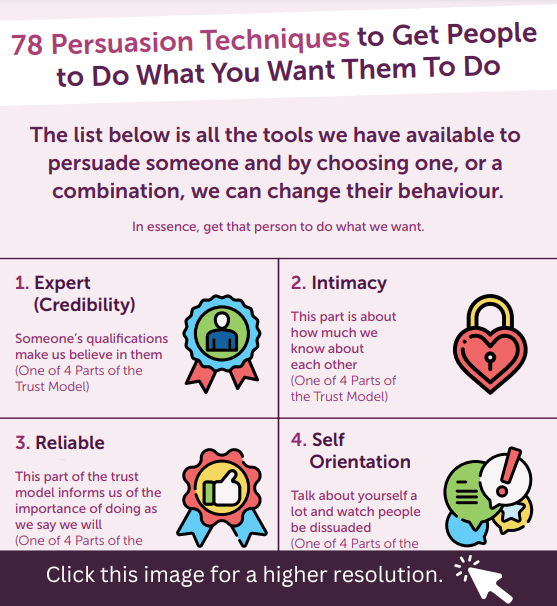
Sticky Learning ® is 7 times more effective than 1-day training courses. Plus, you will get a Chain of Evidence proving your Return on Investment. Discover soft skills training that changes behaviours long term.

The List of 78
- Expert (Credibility) – Someone’s qualifications make us believe in them (One of 4 Parts of the Trust Model).
- Intimacy – This part of the Trust Model tells us that knowing each other ground is important (One of 4 Parts of the Trust Model).
- Reliable – This part of the Trust Model informs us of the importance of doing as we say we will (One of 4 Parts of the Trust Model).
- Self Orientation – Talk about yourself a lot and watch people be dissuaded (One of 4 Parts of the Trust Model).
- Relationship – When someone asks you to trust them because you have known them for a while.
- Consistency – ‘But you gave Bob a pay rise’.
- Fair – Using the word ‘fair’ to encourage someone to be fair.
- Reciprocity – You invite me to your party and then I do the same.
- Empathy – ‘That sounds really tough’.
- We – Using ‘we’, rather than ‘you’ to bring people on-board.
- Liking – We like people like ourselves.
- Common Ground – We like people who like what we like.
- Social Proof – If others like it, we might too.
- Humility – Being humble can win a lot of people over.
- Love – As Meatloaf said, ‘I’ll do anything for love…’.
- Humour – Make them laugh and they’ll be more open to you.
- Cheeky – ‘Go on, give me your number. You know you want to’.
- Emotional Response – You stir an emotion.
- Enjoyment – If you like doing something, you are more likely to do more of it.
- Enthusiasm – Ever been swayed by someone so enthusiastic?
- Compliment – Giving compliments breaks down barriers.
- Praise – A ‘well done’ can move mountains.
- Gift (Bribe) – In the positive, gifts are powerful. In the negative, a bribe is too.
- Please – Saying ‘please’ helps.
- Thank you – A simple ‘thank you’ can go a long way.
- Sorry – An apology can stop a ‘war’ before it starts.
- Belief – If we believe in someone or something we will move mountains for them/it.
- Respect – Respecting someone can drive us to take action.
- Whole world – Ever been speaking with someone and they stop you to read a text?
- Listen – The research tells us that people just want to be heard.
- Courteous – There is a reason why we research, for example how to bow, before we visit Asia.
- Smile – Richard Branson said that a ‘Smile and a handshake go a long way’.
- Guilt – ‘The kids would love to see the tree up’.
- Escalation – ‘Get me the manager’.
- Bullying – Doing what someone wants because you feel intimidated.
- Threat – ‘If you don’t do x, I will do y’.
- Irritator – ‘Of course I know what to do’.
- Competition – We want to beat other people and they want to beat us.
- Time – ‘It will only take you 5 minutes’.
- Time Pressure – ‘We need to get this done before the client notices’.
- Logic – ‘This project is a no-brainer’.
- Repetition – Saying the same thing again, and again, and again, and again.
- Ask – ‘Would you help me to get this done, please?’
- Tell – ‘Go and tidy your bedroom’.
- Words – For example, ‘Because’ is the most influential word.
- Three Words – ‘Get Brexit Done’.
- Halve Your Words – Double your impact.
- Body Language – How we sit, stand, express our face, etc. influences what a person will then do.
- Pause – Using pauses in our sentences can significantly persuade people.
- Storytelling – Stories are one of the most powerful ways to share an idea.
- Metaphors – ‘When I stood on the top deck of Titanic I could see directly into the eyes of the Statue of Liberty’.
- Trigger the Golden Question – How? – ‘We enable learners to change behaviours’.
- Push – One half of an influencing technique that encourages us to share what is on our mind.
- Pull – The other half of the influencing technique encourages us to ask what’s on their mind.
- Negotiate – If you then I.
- Reversing – Influencing can be like two magnets, as soon as you back away, they come to you.
- Swap – ‘What would you do in my shoes?’
- Framing – The lottery is either; A 99.9% chance of winning nothing or a chance of becoming a millionaire.
- Anchoring – ‘Ladies & Gents I’m not going to even ask FOR £25 for this bundle of meat’.
- Door in the Face – Ask for something big to get a no, and then ask for something smaller.
- Foot in the Door – Get agreement to something smaller and you are then more likely to get agreement to something larger.
- Free – Reminding people that they are free to make a decision will help them side with you.
- Confidence – Be confident in what you say and it will carry more weight.
- Clarity – Be very clear about what you want. No waffle.
- Limit Choices – Avoid choice paralysis by offering only 3 options.
- Last Choice – When people offer choices, the one they want is always the last one.
- Plan – If you have a plan of how to achieve something, it can be very persuasive.
- Vision – Sharing a vision of what it looks like when we achieve it.
- Inspire – By inspiring people they will deliver much more.
- Insight – Most colds are transferred in the house by touching the fridge.
- Image – A picture tells a thousand words.
- Necessity – Sharing that they need this, can be compelling.
- Financial – Getting what you want because you paid for it.
- Scarcity – Exclusive deals.
- Plea – A plea for someone to do something can be very effective.
- Wearing People Down – You’ve asked. You’ve pleaded. And you keep on trying.
- Generate Anticipation – Film posters and their trailers do this very well.
- Reduce the Risk – By eliminating risks they are less worried.
What are the Most Common Techniques We Use to Persuade?
I believe we can influence people in over 70 different ways to get what we want. In our lifetime most people have used a bunch of the tools above. They just don’t know that they have.
The 10 most commonly used persuasion tools are:
- 1. Expert – Someone’s qualifications make us believe them
- 9. Empathy – ‘That sounds really tough’
- 21. Compliment – Giving compliments breaks down barriers
- 24. Please – Saying ‘please’ helps
- 34. Escalation – ‘Get me the manager’
- 39. Time – ‘It will only take you 5 minutes’
- 41. Logic – The project is a no-brainer
- 42. Repetition – Saying the same thing again, and again
- 43. Ask – ‘Would you help me to get this done, please?’
- 71. Image – A picture tells a thousand words
Which leaves 68 others techniques that are underutilised. Which ones do you use most? And which ones would you like to add to your toolbox?
How Many Persuasion Techniques Do We Use?
I believe that we each use only 7 persuasion techniques. A little like we only have 7 meals we cook in the evening, as our go-to family-friendly feeders. The 7 meals you cook are different to the 7 I cook with some commonalities, like Chicken Casserole. Persuasion is the same. We both have 7 go-to persuasion techniques with commonality, for example, the most used way of getting someone to do what you want is to explain it to them with logic. For example, Wife to Husband (Though, could be husband to wife) – ‘We need a new refrigerator because the old one has stopped working’.
We couldn’t name the tools of persuasion we use but we do know that we persuade people and that we get frustrated when we can’t, with nowhere to turn for how to persuade them when we are stuck. This article has the power to significantly improve how well you persuade people. It comes with a health warning:
Only read on if you want to start getting people to do what you want…
78 Ways We Persuade People in Real Life – In Detail
1. Expert (Credibility) – Someone’s Qualifications Make Us Believe in Them (One of 4 Parts of the Trust Model)
Ever noticed the certificates on the wall when you visit the doctor? Rightfully so, they are displayed. A doctor studies for many years to be qualified. The certificates are for them and for you. For them to be proud and for you to feel relaxed that you’re in the right hands. You both don’t need to spend time verbally jousting to figure out whether they are credible because the wall says so, leaving you to spend your time getting down to business – figuring out how to make you feel better.
How could you display your qualifications, certificates, awards, and accolades so that others know that you are the real deal? Some use their email signature, others update their LinkedIn profile. Find where people ‘see’ you most and tell them.

2. Intimacy – This Part of the Trust Model Tells Us That Knowing Each Other Ground is Important (One of 4 Parts of the Trust Model)
This is one of the 4 parts of the trust model – intimacy. This part is about how much we know about each other. For example, if I tell you that I have two kids; Gabby and Jack, then you know a little more about me and we have started to build up our intimacy.
As our work relationships grow and we share pieces with each other we gain common ground and increase our trust. Trust is a very important building block of persuasion because you’ll have people that you trust who could ask you to do almost anything and you would without question because you have great trust. Abandon the email opener of ‘Hope you are well‘ and use the opportunity to create trust.
The challenge with trust is that it takes a long time to build but can be destroyed in an instant.
3. Reliable – This Part of the Trust Model Informs Us of the Importance of Doing as We Say We Will (One of 4 Parts of the Trust Model)
We’ve all got that friend who says they’ll be there but you know they’ll bail on you. Probably at the last minute. You both knew that when you asked them to come that there was no way they’d ever turn up. Reliability is one of the 4 parts of the trust model. For friends, we accept it but only for so long.
There are colleagues at work that when you ask them to do something by a deadline, they do. And then there are those that will have every excuse for never achieving the agreed deadline – ‘The dog ate my homework’ type of person.
Building a foundation of trust is important when you want to persuade someone, and building trust is about putting a tick against each of the 4 parts of the trust model.
4. Self Orientation – Talk About Yourself a Lot and Watch People be Dissuaded (One of 4 Parts of the Trust Model)
The fourth part of the trust model is Self Orientation. As a persuader, you can do great things to optimise trust with the other 3 parts of the trust model. Unfortunately, this can all be undone very quickly if you talk about yourself a lot and don’t focus on the other person.
Trust is hard to build and easy to demolish.
5. Relationship – When Someone Asks You to Trust Them Because You Have Known Them for a While
We’ve all been there. A friend, a colleague, or a partner has asked us to do something for them and we refused. They’ve pulled out the relationship card and asked us to trust them. This technique can only be used when you have known someone for a while. It cannot be used often but when it is used it is like having a Royal Flush in Poker.

6. Consistency – ‘But You Gave Bob a Payrise’
As with so many things it comes back to our childhood. If your brother got a sweet you rightly expected one too. You expected your Mum and Dad to be consistent. It is similar at work, we expect people to behave consistently, for them to do as they always have. If someone is being inconsistent this can be an opportunity to persuade them to be consistent. Like when we call Sky and say, ‘But my mate pays only £22 per month for his Sky’.
Asking someone to be consistent in what they did previously is the key to using this tool. For example, ‘You gave Bob investment for his project’.
7. Fair – Using the Word ‘Fair’ to Encourage Someone to be Fair
I could be in danger of stepping on the toes of negotiating. The feet of persuasion are very similar to those of negotiation, but I am sure you’ll allow this particular one because it is very persuasive.
The psychology around using the word ‘fair’ in negotiation is well documented. The word takes us back to our childhood when ‘fair’ was important. Sharing our toys, not being unfair to others, and hearing phrases like ‘fair enough’ a lot. Hearing that we are not being fair or that we should be being fair takes us right back to when we weren’t treated fairly and how wronged we felt.
Be careful not to overuse it. It’s like a wine buyer once told me about using the nose for sampling, it gets tired easily. So does using fair.
8. Reciprocity – You Invite Me to Your Party and I Do the Same
The word is a tongue tier but once you wrap your head around it, it’s a satisfying word to use.
reh – such – pro – such – tee
It’s about owing someone. Calling in a favour. Trading promises. Linkedin works very much that way with ‘following’. If I follow you, you are then compelled to follow me.
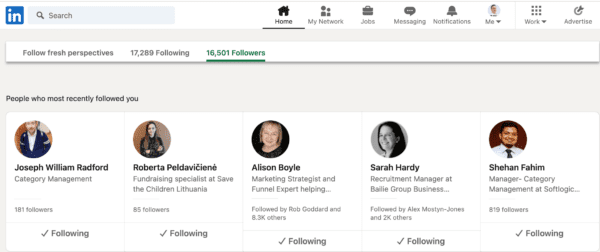
9. Empathy – ‘That Sounds Really Tough’
When you are having a tough day you just need an ear to bend. You don’t want solutions. You want empathy. Someone that understands. The difference between being sympathetic and being empathetic is a fine line, yet a line indeed.
Empathy means experiencing someone else’s feelings. It comes from the German Einfühlung, or ‘feeling into’. It requires an emotional component of really feeling what the other person is feeling. Sympathy, on the other hand, means understanding someone else’s suffering.
By being empathetic with someone, you will enable them to be more open to your persuasion.
10. We – Using ‘We’, Rather Than ‘You’ Brings People On-Board
When I bring a new training associate on board one of the things I look for, to know whether they are on board, is if/when they start using ‘we’ rather than ‘you’. It’s a subtle change by them that they probably don’t notice. It gives away when they are truly engaged with my business. Some never do. Some do quickly. Please open your reticular filter to the small words you and we.
11. Liking – We Like People Like Ourselves
We like people like us. Of course, we do. We’re great, aren’t we? We’re the best. The right ones. We like people that are like us. Look the same and sound the same. In terms of persuasion, it is much easier to persuade someone that is like us.
For example, I wanted to buy a Vespa motorbike. I’d grown up in Essex, UK, and moved to Oxford when I was 11 for my Dad’s job. A red Vespa came up for sale and it was located in Essex, many miles from Oxford, yet I was going back to my roots. When I went to buy it, yes, I dug back to my school days and when the seller and I spoke it was like two old cockneys. Needless to say, he gave me a great price because I was, as he said, ‘…one of us’.
This is why the Apple stores staff are dressed in jeans and t-shirts, rather than suits and ties because they are more likely to look like us.
12. Common Ground – We Like People Who Like What We Like
Well worth watching this video. Particularly the 5th law of persuasion to understand the power of finding common ground – Liking, which starts at 7:42 minutes:
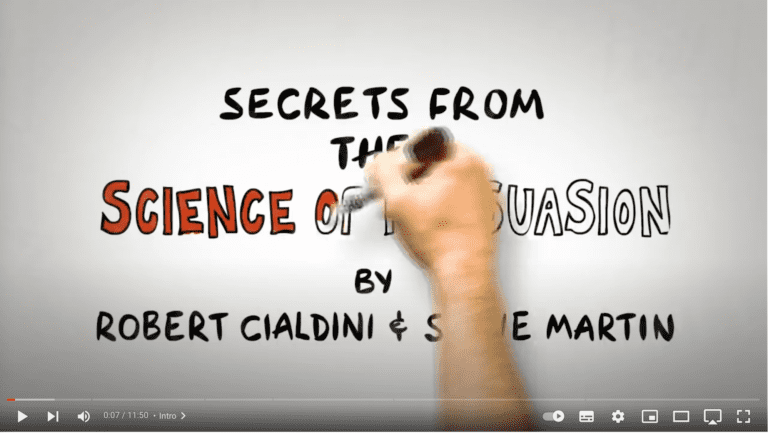
13. Social Proof – If Others Like it, We Might too
Marks and Spencer doe this very successfully on their website.
’26 others people are looking at this. Over 100 sold in the last 48 hours. Must be good’.


This is how Robert Cialdini describes his sixth principle of persuasion – Social Proof
“Especially when they are uncertain, people will look to the actions and behaviours of others to determine their own.
You may have noticed that hotels often place small cards in bathrooms that attempt to persuade guests to reuse their towels and linens. Most do this by drawing a guest’s attention to the benefits that reuse can have on environmental protection. It turns out that this is a pretty effective strategy, leading to around 35% compliance. But could there be an even more effective way?
Well, it turns out that about 75% of people who check into a hotel for four nights or longer will reuse their towels at some point during their stay. So what would happen if we took a lesson from the Principle of Social Proof and simply included that information on the cards and said that 75% of our guests reuse their towels at some time during their stay, so please do so as well? It turns out that when we do this, towel reuse rises by 26%.
Another Example
Now imagine the next time you stay in a hotel you saw one of these signs. You picked it up and you read the following message: “75% of people who have stayed in this room have reused their towel.” What would you think? Well here’s what you might think: “I hope they’re not the same towels.” And like most people, you’d probably think that this sign will have no influence on your behaviour whatsoever.
But it turns out that changing just a few words on a sign to honestly point out what comparable previous guests have done was the single most effective message, leading to a 33% increase in reuse. Science is telling us that rather than relying on our own ability to persuade others, we can point to what many others are already doing, especially many similar others.
From my perspective, for example, when I worked in a corporate business and we were possibly going to be taken over, I looked to a leader I trusted for how he felt about the acquisition. This led to how I then thought about it and subsequently felt about it.
14. Humility – Being Humble Can Win a Lot of People Over
Most people have watched the X-Factor or Britain’s Got Talent. Take two people with equal talents. One is arrogant, and another is humble. We always want the latter person to win, and we don’t like arrogance – we don’t warm to it. However, we do warm to people that show humility because its shows that whilst they have great talent they are not ‘cocky’. They are still willing to seek approval and be even better, and most of all, they are still one of us.
Recently, my son Jack and I went to see a film at the cinema. I had booked the wrong Vue cinema because we had just moved house. Thinking about this research into techniques of persuasion I was thinking about which one to use as I stepped up to the desk at the new cinema. I chose humility – ‘I am an idiot. We just moved. I booked for Oxford and should have booked for Bicester.’ He smiled and whilst he didn’t transfer the tickets from one Vue location to another (against policy!), he did seem to go out of his way to show me how I could easily get my money back. He liked that I had ‘fallen on my sword’ and was willing to help the person that was willing to bare his chest to his mistake.
Carol Dweck of the ‘Growth Mindset Vs Fixed Mindset‘ fame talks a lot about being a leader with humility because those that are, demonstrate the ability to see what they still need to improve, and then do so. Humility can be a great persuader. Maybe one to add to your persuasive toolbox?
15. Love – As Meatloaf said, ‘I’ll do Anything for Love…’

16. Humour – Make Them Laugh and They’ll be More Open to You
A good colleague of mine, Alan, uses humour exceptionally well. He’s not a stand-up comedian and does not crack a huge amount of jokes. What he does very well is to identify when a situation is tense and brings some humour into it to get people working together again to listen to each other.
A tough ask for most of us, but if you can, do.
17. Cheeky – ‘Go on, Give Me Your Number. You Know You Want to’
The cheeky encouragement. Sometimes it’s just about encouraging the other person to ‘step forward’. Encouraging, but with an almost humourous tone. In this video, at 1:09 minutes Mona does a cheeky piece of encouragement on BBC’s The Apprentice. An expert class in cheeky encouragement.
18. Emotional Response – You Stir an Emotion
Car adverts illicit feelings of freedom or going fast, or absolute comfort. Or a yellow lawn, weeds, and dead plants make you feel sadness and guilt. Then they show the sun, a fine green lawn and colourful plants – this is how the garden adverts make us buy their products.
McDonald’s makes the kids happy. Captain Bird’s Eye makes Mum feel that she is feeding the kids something nutritious with its Omega-3 flashes on the pack. Virgin used to make us feel that we are ‘sticking it to the big boys’.
When we are getting people to do what we want this persuasion technique is all about considering first how we want them to feel. For example, it might be a high-profile project and we want them to feel included and proud. Or we have been working silly hours and asking for their help, we’d like them to feel empathetic. Or presenting an insight to a group with the objective of making them feel amazed by what you have achieved.
What emotion would you like them to feel when you persuade them of x?

19. Enjoyment – If You Like Doing Something, You are More Likely to do More of it
That’s why people have hobbies. Do people like having meetings with you? Talking with you? Going to your presentations?
A colleague of mine has the enjoyment factor. People like speaking with him, being with him, they like him. I realised a long time ago that I was never going to be this guy so I stopped trying to be him and started being me. Likeable, just perhaps not as likeable as him. The lesson here is that some of these persuasion techniques are not for us and that is OK. We need to be the very best version of ourselves and doing that means that we need to use the tools that we can use. Not those that others can use.
20. Enthusiasm – Ever Been Swayed by Someone so Enthusiastic?
Ever had the ‘wave of enthusiasm’ wash through you? Someone so enthusiastic about an idea that you just couldn’t help but be carried away by what they wanted to do.
21. Compliment – Giving Compliments Breaks Down Barriers
Everyone likes a compliment. Mind, it has to be genuine. False compliments can be sensed a mile away and will also push your persuadee a mile away too.
How to give a compliment:
- Find something you like about that person. Even if you have known them forever:
- ‘Thank you for being a great friend all these years.’
- Or, for a colleague, ‘We work really work together. thank you for making you easy to work with’.
- Say it.
- Practice: Repeat the same technique each time you meet someone.
22. Praise – A ‘Well Done’ Can Move Mountains
What we are not doing here is, ‘You did a great job. Can you now do all this stuff over here?’. That’s the dark side of using persuasion techniques and often won’t work. What we are doing is genuinely praising someone that has done a great job and remembering to add why, which is a key part of the SBI model of giving feedback. Then, in the future, when you want to persuade someone to do what you want them to do, it will be heard much more favourably.
23. Gift (Bribe) – In the Positive, Gifts are Powerful. In the Negative, a Bribe is too
Bribes are obviously in the negative column of persuasion. Yet, genuine gifts to say thank you build the foundation of a relationship that can make future persuasions much easier.
When did you last send a little something to say thank you? Or even a card to say thanks. At Christmas, we send our clients a self-development book. Last Christmas we sent them all a copy of Malcolm Gladwell’s ‘Bomber Mafia’.
24. Please – Saying ‘Please’ Helps
Back to our childhood when we learnt our manners and the importance of being polite. A ‘please’ can make all the difference.
In the film ‘A Few Good Men’, Colonel Jessep (Played by Jack Nicholson) says to Lieutenant Kaffee (Played by Tom Cruise), ‘You have to ask me nicely’.
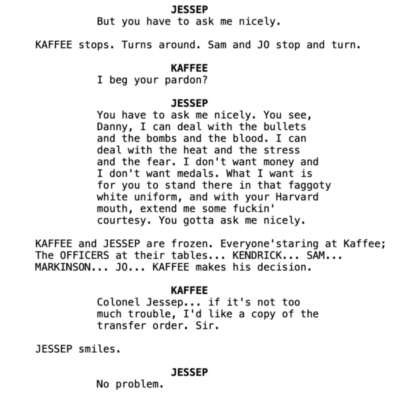
25. Thank you – A Simple ‘Thank You’ Can Go a Long Way
Thank you for taking the time from your demanding day to read this article because I believe it will help you to be the very best version of yourself.
Which 4 persuasion techniques did I use bove?
Thank you + Empathy + Because + Vision.
26. Sorry – An Apology Can Stop a ‘War’ Before it Starts
Sorry seems to be the hardest word, Elton John.

27. Belief – If We Believe in Someone or Something We Will Move Mountains for Them/it
You don’t need me to tell you the story of Nelson Mandela. He believed and got a nation to believe too. Or Martin Luther King or JFK with his space mission. If we can get people to believe there is no end to what is possible. Or on a sadder note, Jim Jones of Jonestown motivated his ‘flock’ to commit mass suicide. They believed in him.
Why did people believe in these people? They spoke with unwavering belief.
28. Respect – Respecting Someone Can Drive us to Take Action
For example, Captain Sir Tom Moore walked laps around his garden raising £33m for the NHS. Out of respect for his service as a veteran and his commitment to walking around his garden at 99 years of age, we gave huge amounts of money.
Why should people give you their respect?
29. Whole World – Ever Been Speaking With Someone and They Stop You to Read a Text That has Just Come in?

Drown out any and all distractions because it will show the person how important they are. A phone ringing, someone texting, or an assistant banging on the door – ignore them because the person right in front of you is the most important person in the world right now and they have all of your focus, and your attention.
Don’t let a minor distraction create a big resentment.
30. Listen – The Research Tells us That People Just Want to be Heard
In call centres, agents are taught to actively listen to the customer when there is a complaint. Not trying to defend the problem, but understanding the problem first, almost like taking the wind out of the sails of the complaint by seeking to understand the problem. Letting the customer run out of steam because we often just want to be heard.
For example, you often see two people trying to persuade each other of their point of view. Their speed of speech increases, their volume increases, and their tone becomes stronger. Neither will persuade the other. It’s now about who can be heard the most, yet neither person is listening.
For one person to say, ‘This is not working. We’re not listening to each other. How about, I listen to you, and then you listen to me?’. It might just work.
31. Courteous – There is a Reason Why We Research, for Example How to Bow, Before We Visit Asia
Good old-fashioned courtesy. Remember that courtesy is different in different parts of the world. If we visit China on business most business travellers will have googled the traditions because they want to be courteous to their host, as we would expect someone visiting the UK. Courtesy matters. Many a contract has been lost because the prospect was thought to be rude.
32. Smile – Richard Branson said that a ‘Smile and a Handshake Go a Long Way’

33. Guilt – ‘The Kids Would Love to See the Tree Up’
You can imagine the scenario – Mum has come home from a long day at work. The kids are chomping at the bit because the tree has been delivered and it just needs setting up. Dad has come in after a long day too. Granny has been looking after the kids all day and has seen how excited they are to get the tree up. Granny says, ‘The kids would love to see the tree up’.
What choice do Mum and Dad have but to go get the Christmas decorations from the loft and set up the tree? Guilt can be very persuasive.
34. Escalation – ‘Get Me the Manager’
We’ve all been in that situation where you were so frustrated that it was time to escalate. Be it in a restaurant or speaking to a call centre, you thought asking for the manager was the answer. We wanted a higher-level person that could do more because we were getting nowhere with the more junior person.
You obviously burn your relationship with the ‘junior person’ and may get somewhere with the higher-level person. It’s a gamble and sometimes you need to roll the dice when you feel that you have no other options. Rarely do we do it at work because we have long-term relationships.
35. Bullying – Doing What Someone Wants Because You Feel Intimidated
One of the negative techniques on our list. Not to be condoned.

36. Threat – ‘If You Don’t do x, I Will do y’
Let’s park this persuasion technique in our ‘not to do’ group. However veiled threats, in negotiation can be very useful.
37. Irritator – ‘Of Course I Know What to do’
This will never get anyone to do what you want. People use it to persuade, negatively. It is used out of frustration and is a game changer in that it will kill the persuasion dead. Watch the irritators in our video below – look for the Heineken video.
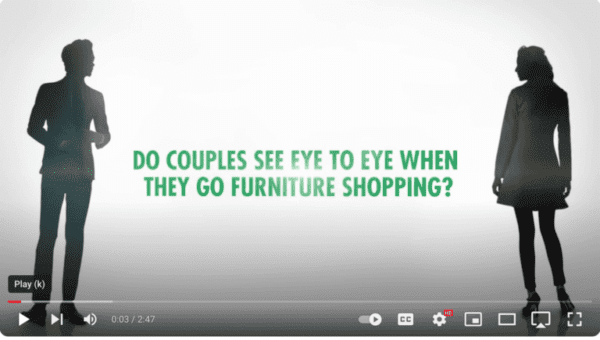
38. Competition – We Want to Beat Other People and They Want to Beat Us
For example, setting a sales target for each person including yourself. ‘You get a bonus if you beat your target and a further bonus if you then beat my target too’.
For example, I was once standing at an exhibition stand. Not very interesting, not many prospects to the stand and I was half-heartedly handing out flyers. My colleague came along and said, ‘No one and I mean no one walks past without a flyer. Agreed?’. I agreed. He was so enthusiastic, I had to.
Every person that came past us received a flyer, no matter what they said or how they tried to fob us off. He had made a boring task fun by competing with me. Then, a guy staggered past carrying a tower of 6 boxes, his legs were bowing, and he looked at us as if to say, ‘This is gonna go any minute’. Yep, you guessed, Mark did a standing jump to place a leaflet on the very top box. Possibly the straw that broke the camel’s back. We still laugh about that today.
39. Time – ‘It Will Only Take You 5 Minutes’
I believe this is the most commonly used persuasion technique. You hear it all the time. One office worker to another asking for some help, and quick as a flash the response to grumbling about being too busy is always, ‘But it’ll only take you five minutes’.

This is a very valid persuasion technique and is very effective. It just shouldn’t be one of only a few persuasion techniques in our persuasion toolbox. The challenge isn’t to remember them all, it is to select a few more, and practice them until you have a bigger toolbox.
40. Time Pressure – ‘We Need to Get This Done Before the Client Notices’
It does what it says on the tin. Put the persuadee under time pressure.
41. Logic – ‘This Project is a No-Brainer’
One of the top 3 persuasion techniques that we use. Logic. It’s powerful and well, logical. Spock would be proud of this one and probably because it is his only one. Powerful, nonetheless. Just over-used, and could be replaced, at times, by others.
42. Repetition – Saying the Same Thing Again, and Again, and Again, and Again
Another commonly used technique for getting people to do what you want. It’s not in the realm of wearing people down (see that one on the list). Repetition is the go-to for many people. By telling them again and again we feel as though we are persuading them, yet we didn’t select this technique because we thought they hadn’t heard or that they need to hear it again. We have selected it because it is our go-to.
For many people, it just irritates them to hear it again and again, and yet we use it nonetheless. What most people want to say having been told the same thing 3 times is ‘I hear you. I just don’t agree. There’s a difference’. What in fact actually happens is that the repetition often leads to irritation and irritation to conflict.
In summary, an overused and ineffective persuasion technique that needs retiring like an old horse.
43. Ask – ‘Would You Help Me to Get This Done, Please?’

Simple. Ask. But ask with clarity. Ask for what you want. It might just be that you were so worried, and nervous that you hadn’t actually asked but instead used a lot of words, only to be received with ‘What is it that you actually want?’.
There’s no harm in asking. But do actually ask.
44. Tell – ‘Go and Tidy Your Bedroom’
Parents to children or sergeants to privates – tell is likely to only work where the structure is such that tell is accepted. Even leaders in large organisations try to get buy-in rather than ‘You will do this’. Rather than JFDI (Just F’ing Do It). This is a persuasion technique reserved for exceptional times or for when you join the army. Hopefully, you will get through the ranks so you can use it, rather than be subjected to it!
45. Words – For Example, ‘Because’ is the Most Influential Word
The words we use are important and when you realise how very important certain words are, you realise that you can improve your ability to persuade significantly.
For example, ‘because’. A famous piece of research is worth reading. Psychology Today reports this research well. In essence, the study shows a person queuing to use a photocopy machine (this was many years ago). The question below was asked in the study and the result was that using ‘because’ increased the response by more than half. Yet, the surprise is that it did not matter what the reason was.
- “Excuse me, I have 5 pages. May I use the Xerox machine?”.
- 60% of those asked responded yes.
- “Excuse me, I have 5 pages. May I use the Xerox machine because I have to make copies?”.
- 93% of those asked responded yes.
- “Excuse me, I have 5 pages. May I use the Xerox machine because I’m in a rush?”.
- 94% of those asked responded yes.”
46. Three Words – ‘Get Brexit Done’
The ex-Prime Minister of the UK, Boris Jonson, used this persuasive technique to help the UK get passed the problem of floundering over Brexit. Donald Trump’s ‘Make America Great Again’ didn’t feel as compelling. This is because the 3 words are essential. Not 2, and not 4. Three – Get Brexit Done.
Throughout human history, the number 3 has always had a unique significance. The ancient Greek philosopher, Pythagoras, postulated that the meaning behind numbers was deeply significant. In their eyes the number 3 was considered the perfect number, the number of harmony, wisdom and understanding.

Become Persuasively Powerful.
47. Halve Your Words – Double Your Impact
I struggle with people who talk a lot. Especially those that manage to use 4,012 words when 9 would have done. For most people, we are happy to be talked at for a bit and then we mentally switch off. This technique is a reminder to those that might use a lot of words that you might be more persuasive to switch it up and use less. Fewer words will create more impact.
Men of few words are the best men – William Shakespeare
48. Body Language – How We Sit, Stand, Express our Faces, etc. Influences on What a Person Will do
Being aware of our body language matters when it comes to persuading people. Body language influences people and this is concluded in the Albert Mehrabian formula:
- Our body language conveys 55% of the message.
- The tone of our voice represents 38%.
- Our actual words convey only 7%.
Though, this formula is misunderstood because what Albert was actually saying was not that our words only account for very little. He was in fact saying that when there are mixed messages, we look at the body language more closely, followed by the tone.
For example, a child wants a dog and asks his Mum. His Mum says, ‘I’ll think about it’. Her body language and tone say, ‘Absolutely not’. This 3-minute video explains it well.
Our takeaway is to learn the basics of body language so that you can ensure that your message is congruent throughout your body, tone, and words. Otherwise, you will be less persuasive. While the other person might not understand body language, they will be able to pick up on your inconsistent message, even if they cannot explain why it is inconsistent.
49. Pause – Using Pauses in Sentences can Significantly Persuade People

JFK used the power of the pause. He did this particularly well during his Famous Berlin speech. Often, in an effort to persuade people, we hurry through the ‘pitch’ enthusiastically forgetting that we completely understand what we want because we have practised it a hundred times, but not keeping in mind that this is the first time they have heard it and they’ll need time to digest what we are saying.
Slow down. Use a pause. Colin Firth did this very well in the film ‘King’s Speech’.
50. Storytelling – Stories are One of the Most Powerful Ways to Share an Idea
Read this article about storytelling to know why it sticks with us for so long.
Many years ago a sales coach of mine was running a storytelling workshop. I didn’t want to go because I hate telling stories. He made me attend. The inevitable happened and we were put in 3’s and asked to tell each other a story. Just before we began the sales coach asked the room a question, ‘Who believes that they can’t tell a story?’. Most of us put our hands up. He then changed the instruction slightly and shared that he wanted us to tell a story, ‘…But I want you to tell a story about when injured yourself’. We all looked at each other strangely. Then we began.
Before 5 minutes went by, you could look around the room and there was a guy taking his shirt off to show the most horrific scar from a motorbike accident, another person was standing up showing people the actions on a skateboard and me…yes, I was at it too. They couldn’t stop me. ‘…and when the Stanley blade cut through, you should have seen the…’. You can imagine.
The point?
We can all tell stories. We just need to start.
51. Metaphors – ‘When I Stood on the Top Deck of Titanic I Could See Directly into the Eyes of the Statue of Liberty’
Powerful, metaphors are. Very powerful. It doesn’t matter whether it is absolutely correct. Find a metaphor to help you to persuade them. James Dyson was famous for his advert where two vacuum cleaners are in front of a big pile of dust each. The dust is actually dynamite and the guy lights the dust that is left. Needless to say, there is no explosion with the Dyson.
52. Trigger the Golden question – How? – ‘We Enable Learners to Change Behaviours’
Our elevator pitch is:
We are the soft skills training provider, partnering with clients that are frustrated by their people returning from training courses and then doing nothing differently. Our clients choose us because we achieve behavioural change through our unique training method, sticky learning ®.
It is on the home page of our website. It says what we do, the problem we solve and why clients choose us. The key question we want back is ‘How?’. A prospect to ask ‘How do you achieve behavioural change?’. When they ask we can then share with them our training course blueprint – sticky learning – and how we prove their return on investment using our chain of evidence.
When you want to persuade someone to do something, have in mind that your ‘pitch’ is wanting to get back ‘How?’ because it means that they are intrigued enough to want to know more.
53. Push – One Half of an Influencing Technique That Encourages Us to Share What is in Our Mind
The push and pull influencing technique is an effective tool for persuading people because it asks us whether we should share or ask the other person to share. Often, situations call for one or the other, yet we stick to our natural behaviour, which might be to share (push) or for the other person to share (pull). Push is about sharing what’s in our head; our vision, our thoughts, our way forward, etc.
Click the image below for the full, high-resolution version.
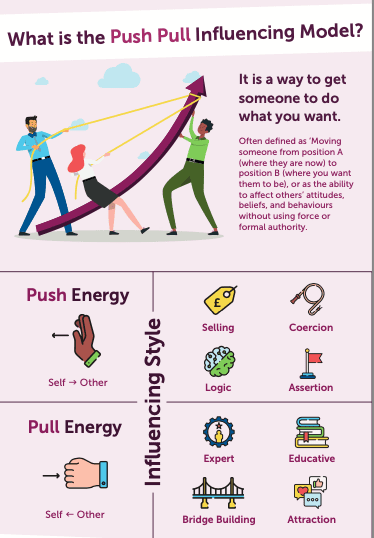
54. Pull – The Other Half of the Influencing Technique Encourages Us to Ask What’s on Their Mind
Pull is all about asking for their thoughts. The old phrase is useful to remember here, ‘A penny for them’. We want to get into their head and swim around. Know what their thinking, their thoughts, their take on a situation, etc. Use this technique:
- Ask an open question.
- Wait for the answer.
- Repeat.
55. Negotiate – If You Then I
This persuasion technique is a negotiation tool that can help persuade someone to get what you want. The tool helps you to phrase what you want so that the person listening, really listens. You might want to buy a second-hand car. Most people would fumble their way through trying to get the price down. This tool helps you propose the right offer by saying, ‘If you can let me have £500 off of the price, then I will give you cash’. The reason it works is that the bit they want – the cash part – is second in the second sentence, so they have to listen to what you want in order to hear what they can get in return.
Watch a short video to hear me talk about this negotiation tool.
‘If You Then I’ is a key negotiation tool that can be used in persuasion too.
56. Reversing – Influencing Can be Like Two Magnets, as Soon as You Back Away, They Come After You
Remember being at school and really liking a girl? Chasing her (Maybe literally!), sending her notes, and telling her friends how much you like her. Nothing back. Then, you start to turn your attention to another girl and then her attention turns to you.
It’s similar to prospecting when you are selling. Chase them too hard and you repel them. Intrigue them, and they come back. Remember, people don’t want to be sold to, but they do want to buy. This is a subtle but important difference to remember.
57. Swap – ‘What Would You do in My Shoes?’
The success of this persuasion technique is determined by how you ask. Many of the questions we ask are not genuine questions. For example, when I used to ask my son, ‘Will you do the dishwasher today?’. He and I knew it wasn’t a question. In conflict people often ask questions that aren’t real – ‘So, what do you want me to do about it then?’.
Successfully using this technique pivots on the tone you use. It must be used in a soft and gentle tone, with the objective of really asking a question about what they would do in your situation and then listening to the answer. By doing it this way you might get the person you are trying to persuade to become empathetic with your situation and even come around to your way of thinking and ultimately do what you want them to do.
58. Framing – The Lottery is Either; A 99.9% Chance of Winning Nothing or a Chance of Becoming a Millionaire
Re-framing is one of the tougher techniques of persuasion to get your head around. It involves re-framing what you are proposing in a way that appeals more seeing it from another perspective. A bit like the famous 6 or 9 image:
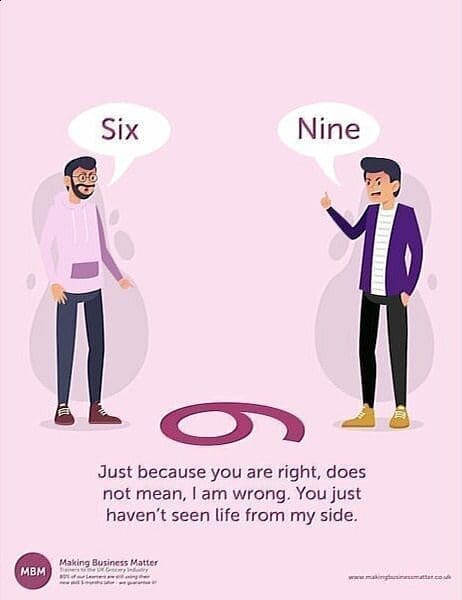
Example #1
The initial framing of asking someone to do a task for you in the office might be, ‘Please could you do the analysis on the Andrews project for me?’. This initial framing could become:
- ‘I don’t want to ask Ian to do the analysis on the Andrews project because he’s working on the Fishers case’. Or…
- ‘I really need my best analyst on the Andrews project because it is a key growth client’. Or…
- ‘I could do the analysis on the Andrews case but we know that it won’t be as good as yours’.
Example #2:
Needing a member of your team to stand in for a meeting. Initially, it might be, ‘Please could you stand in for me at the ABC meeting on Friday?’. This could be ref-framed as:
- ‘I cannot make the Exec meeting on Friday. It would be a good meeting for you to make a good impression’.
- ‘I could have chosen you, Mike or Sue, to stand in for me at the Exec meeting. I’d like it to be you because you understand the XYZ’.
- ‘On Friday is the Exec meeting. I cannot make it. Who would you like to attend, you, Mike, or Sue?’.
Example #3:
Here’s an interesting scenario where reframing created an uptick in survey responses from 30% to 50%. Students asked strangers, “I’m a student, and I need to conduct a study to get credit for one of my courses. Could you please help me? I need this questionnaire filled out: it contains 142 questions.”
The above was later reframed as follows, which garnered more responses: “…I need this questionnaire filled out. It contains 142 questions. We need to elicit answers from intelligent persons, and you appear to be one of them.”
A great piece of re-framing. This child sees the world a whole different way than the other child:

59. Anchoring – ‘Ladies & Gents I’m Not Going to Even Ask £25 for This Bundle of Meat’
The man on the market selling meat anchors us to a higher price by saying phrases like, ‘I’m not going to ask for £25’. We then think that this is possibly worth £25. He goes on to say that he won’t even charge us £20, or £15. Now we think we have a bargain at £12.50.
Anchoring is about putting the first thought in your persuadee’s mind on a new topic because this automatically biases their future opinions. An anchor is a thought that influences people toward a persuader’s preferred outcome. It pulls you in a certain direction – anchors you to a notion. So, by our meat seller first sharing £25, he has anchored us to this notion of the value possibly being £25.
The very interesting part is that according to research the anchor can be unrelated. For example, if you wanted to get a better deal mentioning any higher numbers will increase the odds of you getting the better deal. You might be asking for £11 per case – a cost increase – and by saying, ‘My son is 14 today’, using any higher number will help your cause. A tough one to get your head around – a head-scratcher – but worth a try – what have you got to lose? (See what I did there!? Reframed).
The Economist Case Study
Another case study tells us about The Economist magazine. It used to have three different subscription options. A. Online for $59, B. Print for $125 and C. Print & Web for $125. In a study of 100 MIT students, 16 chose option A and 84 chose option C. The study then removed option B and gave the same test to another 100 students. In this case, 68 chose option A and 32 chose option C. The conclusion is that people use option B as an anchor. No one would actually choose it, it was just used to increase the value of option C.
60. Door in the Face – Ask for Something Big to Get a No, and Then Ask for Something Smaller
For example, teenagers that are going out, say to their Mum & Dad, ‘Can I borrow £20 please?’. ‘Certainly not’, shouts back the parent. ‘How about only £10 instead?’. The teenager gets it.
A study was conducted on whether this technique would help with retail sales. A saleswoman was selling cheese to people walking past a hut in the Austrian Alps. In the first scenario, the hikers were offered a pound of cheese for 4 euros. In the second scenario, the saleswoman first offered 2 pounds of cheese for 8 euros, and after being rejected, asked for a pound for 4. The compliance rates are strikingly different: 9% for the first request and 24% for the second.
When negotiating we might ask for a higher increase in cost to be happy with a smaller one. make sure your initial ask can still jump the line of credibility.
61. Foot in the door – Get Agreement to Something Smaller and You are Then More Likely to Get Agreement to Something Larger
In the 6 Laws of Persuasion video, Rober Cialdini talks about the law of consistency. He talks about a sign in the window and that if someone would accept a small sign in the window, let’s say to vote for a political party, then they’d later accept a larger poster doing the same. Mike Southon, author of the ‘Beermat Entrepreneur’ shares with us that you should always sell the small thing first because of the same principle.
Psychologists first examined the FITD phenomenon in 1966. This was when pedestrian salesmen were in their heyday. Freedman and Fraser of Stanford University conducted a famous study. This was later published in the Journal of Personality and Social Psychology. The title was, ‘Compliance Without Pressure – The Foot-in-the-Door Technique.’
Their first question was, “How can a person be induced to do something he would rather not do?”. First, they asked a group of people for a small request by telephone and later asked them for a larger request in person. The small request made by telephone was for people to report on what type of household cleaning products they were using. The second and bigger request was for subjects to allow a researcher into their home to examine their household product brands and usage. When compared with the control group, who was merely asked for in-home product analysis, subjects who had first responded positively to the first request were 135% more likely to respond positively to the second request.
For example, at work, you might ask someone to do a small task for you, and then next week ask them to help you with a bigger task. This is effective because once someone has helped they’ll want to be consistent and help again.
62. Free – Reminding People That They are Free to Make a Decision Will Help Them Side With You
Also known as the BYAF (But you are free) persuasive technique. The ‘but you are free’ compliance-gaining technique operates by telling the target that they are free to refuse the request. Christopher Carpenter, an Assistant Professor PhD from the Department of Communication at Western Illinois University (WIU) completed an analysis of 42 studies of this technique. His meta-analysis of the studies of the effectiveness of that technique indicated that it was an effective means of increasing compliance rates in most contexts.
To execute this technique of persuasion, Christopher tells us that:
- What is important is that the request is made face-to-face: the power of the technique drops off otherwise. Even over email, though, it does still have an effect, although it is somewhat reduced.
- It was effective regardless of the type of request, but effectiveness diminished when the decision to enact the target behaviour was not made immediately, consistent with a self-presentation explanation of the technique’s effectiveness.
In the control condition, the experimenter made a simple direct request, ‘Sorry, Madam/Sir, would you have some coins to take the bus, please?’’. The experimenter added, ‘But you are free to accept or to refuse.’ Those in the experimental condition were substantially more likely to comply with the request.
Moreover, those who gave in the experimental condition gave twice as much as those in the control condition. They developed the BYAF technique on the basis of psychological reactance theory (Brehm, 1966). Purportedly the phrase weakens the target’s perception that her or his freedom to say ‘no’ is being threatened.
63. Confidence – Be Confident in What You Say and it Will Carry More Weight

Selling our wares at a car boot sale, you’d be amazed by the difference a confident tone can make versus one that it is not. An almost nervous tone responding to ‘How much is this?’ invites the buyer to give you a lower price, but a confident tone, often does not. Read my article about sales confidence.
64. Clarity – Be Very Clear About What You Want. No Waffle.
A good friend of mine is a Sales Director and many years ago he and his account manager had a meeting at a second division UK supermarket. He was called in because his business, being a supplier, they had screwed up resulting in a product recall. They knew that it was going to be a tricky meeting and the question was really how big was the ask for money. They were nervous. I remember him calling me afterwards because I was interested in the question, and he surprisingly said, ‘I think they’ve asked us for money but I don’t know’. It turned out that the buying team weren’t prepared and so they waffled about it being a big mistake and costly but weren’t clear on asking for money or how much.
Be clear on what you want. Ask.
65. Limit Choices – Avoid Choice Paralysis by Offering 3 Options Only
Barry Schwartz, in his Ted Talk, shares with us his thoughts about jeans. He is frustrated at how he used to be able to choose from a few pairs of jeans and now he walks into a store selling jeans and he has no clue because the choice is too wide, too varied, and he is overwhelmed with choice.
Another great example is the famous ‘Jam research’. In essence:
In 2000, psychologists Sheena Iyengar and Mark Lepper from Columbia and Stanford University published a study about jams. On a regular day at a local food market, people would find a display table with 24 different kinds of jams. Then on another day, at that same food market, people were given only 6 different types of jam choices.
Guess which display table led to more sales? Exactly – 6.
Limit people’s choices to avoid paralysing them with too many choices.
66. Last Choice – When People Offer Choices, the One They Want is Always the Last One
As a child, I remember my Mum asking me what we’d like to do at the weekend. I knew then, somehow, that I was supposed to say the last one. ‘Would you like to see your friends, clean out the Budgie, or come with me to see nanny?’, Mum would say. When people ‘present’ options, it’s a way of softening the blow. They offer the illusion of choice, yet it is the last choice they want you to pick. Be aware.
67. Plan – If You Have a Plan of How to Achieve Something, it can be Very Persuasive
When I was a Supermarket Buyer I always appreciated a supplier’s plan. Whilst plans don’t necessarily appeal to my way of thinking, I do appreciate their value. I knew that if the supplier had a plan then they had put some serious thought into how we would achieve XYZ. I might not like or agree with their plan, but at least it was a way forward that I could then build upon.
In persuasion, a plan doesn’t even need to be particularly comprehensive. It could just be, ‘Right, first we’ll get the shopping, then we’ll have a bite to eat’.

68. Vision – Sharing a Vision of What it Looks Like When We Achieve it
The most famous vision sharers were JFK when he talked of going to the moon, Martin Luther King when he dreamt of black boys holding hands with white boys, and Churchill’s ‘We will fight them on the beaches’.
Politicians are very good orators and many are very good at sharing their vision. Us, not so much. We don’t seem to be able to. If we do, it is usually with Powerpoint as we watch people try to stifle their yawns.
Sharing your vision does not have to be Churchill-like in its endeavours, it can simply be describing what you see. What does it look like, sound like and feel like? For us at MBM, our vision is for us to have helped people to become the very best version of themselves. People going home on-time, getting great deals, leading well, and so on. We are feeling bloody awesome because they are feeling great and they are crediting us with themselves being the best they can be by shouting from the rooftops that we made their learning stick.
69. Inspire – By Inspiring People They Will Deliver Much More
There are lots of ways to inspire people and many of these are covered by the other persuasion techniques listed. For example, storytelling, belief and pictures. This technique focuses on believing in them. Sharing with a person that you believe can achieve great things and then giving them the resources, freedom, and space to achieve much more.
70. Insight – Most Colds are Transferred within the House by Touching the Fridge
Insights can be extremely powerful.
The authors of a book called ‘Made to Stick‘ – Chip and Dan, share a great example of the US Shark Association where the association wants to help people understand that sharks aren’t as dangerous as everyone believes. They fail. Chip & Dan then arrive and offer a sticky solution. They ask one question on the front page of the USA website – ‘Which of these animals is more likely to kill you? The user can choose between a Shark or a Deer. The answer is that you are twelve times more likely to be killed by a deer (Hitting your car).’
Powerful insights can make you rethink what you believe.
71. Image – A Picture Tells a Thousand Words
You’ve heard the Chinese proverb that a picture tells a thousand words. Like this one below. You could explain to someone that fishing is hurting sea life, show them graphs of the effects over time, and share infinite facts, but it really comes to life when we see the picture below.
The picture drives our emotions and persuades us much more than any amount of words could ever do.

72. Necessity – Sharing That They Need This, can be Compelling
If you have seen the film ‘Wolf on Wall Street’ or heard of Jordan Belfort or ‘Sell me this pen’, you’ll understand necessity. Jordan’s teaching is that you can describe the benefits all day long but it’s not until you can’t write your signature and you need to, that you need a pen and will buy a pen.
Selling is not about talking at people, it’s about asking questions to establish what they want. Prospecting is not about doggedly hunting for people to sell your product/service to, it’s about finding people that have the problem for which you have the solution. As my old sales coach you to say when I was going to a prospecting meeting, ‘Be the doctor. Identify the pain’.
Necessity, in persuasion, is about finding out whether they need, not what you are offering.
73. Financial – Getting What You Want Because You Paid for it
Financial bonuses persuade people to work harder and stretch themselves to achieve more. We can incentivise people to do what we want with money. For example, a retailer does not want to list your product. You could persuade them by offering to pay a listing fee, covering any wastage costs, and paying for the labour in-store to merchandise the product. Financial incentives can be about who carries the risk and by carrying the risk you persuade them to do what you want. A financial persuader can be very positive. Don’t use it in the negative.
74. Scarcity – Exclusive Deals
According to British Airways, the famous supersonic plane ‘Concorde’ was most booked after BA announced that it was stopping flights on Concorde forever. Scarcity is a key influencer in what we do. Brands like Rolex, Gucci, and Stella Artois have traded on this principle with their branding. In fact, Stella Artois made it their brand equity by promising customers that they were:

booking.com also do the same with ‘Only 5 rooms left on our site’:

75. Plea – A Plea for Someone to do Something can be Very Effective
Very close to please, yet different. The please persuasion technique is very simple and one that we use every day. The plea is led by a change in our tone and body language. Not usually our words. Someone pleading for you to do something is normally accompanied by their tone becoming drawn out and their body language more submissive. Maybe even them doing the praying hands.
76. Wearing People Down – You’ve Asked. You’ve Pleaded. And You Keep on Trying
Kids are great at this:
I want a lolly, I want a lolly, I want a lolly, I want a lolly, I want a lolly, I want a lolly.
‘Have a lolly…you little…’.
Not so useful in the adult world, yet still a valid form of persuasion.
This reminds me of the phrase by Ray Kroc, the founder of McDonald’s:
“Nothing in the world can take the place of persistence. Talent will not; nothing is more common that unsuccessful individuals with talent. Genius will not; unrewarded genius is almost a proverb. Education will not; the world is full of educated derelicts. Persistence and determination alone are omnipotent.”
Sometimes the only thing you know when you give up is that you didn’t get xyz.
77. Generate Anticipation – Film Posters and Their Trailers do This Very Well
Films, theatres and product launches tease us with their upcoming delights. Creating anticipation for their products. It is a powerful technique of persuasion to get people to do what they want. In this case, buy. We can do the same.
Upcoming presentation? When did you last send an intriguing email, flyer, or video tantalising them?
78. Reduce the Risk – By Eliminating Risks They are More Tempted

Some years back, for example, a ready-meal supplier launched a brand. I was the buyer. He knew that I’d be concerned about waste (stock loss) in my stores. He took away my main concern by offering to pay for any waste. When we want to persuade someone we need to reduce the downside for them. Take away their risk, allowing them to more easily say:
Yes.
79. (Bonus) Physical Persuasion Technique – Using Our Hands
When we want to persuade someone we need to remember that what we say is important, and also our hand movements are too.
1. Mirroring the Number with Your Hand
By using your hand to also say what you have just said, e.g. ‘two’, you are reinforcing your message to make it clearer.

2. Holding Your Hand Over Your Heart
By doing this you are affirming that you have an emotional attachment to this part of your presentation or that they should absolutely trust you on this point.
3. The Finger-and-Thumb circle – Also Known as the Precision Grip
A very powerful physical persuasion technique as it demonstrates that you have control of the facts. It is very useful in helping to make a key point.
Ethologist Desmond Morris suggested that the circle shape formed often is associated with perfection hence the gesture’s message that things are ‘exactly right’.

4. Palms Up Wins Hands Down!
Watching Allan Pease in this Ted Talk you’ll understand the importance of holding your hands with your palms up. Versus palms down and finger pointing, palms up engage an audience much more positively. In fact, 40% more.
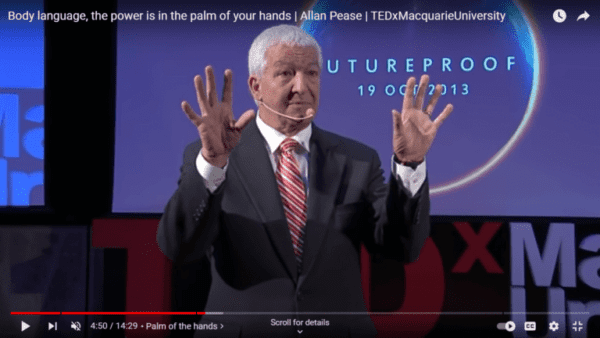
Watch Persuasive Techniques in Action in this Video
Heineken did an experiment whereby the guys had to persuade their partners to buy some chairs. Chairs they would not like. Plastic stadium chairs. If the guy managed to persuade their partner to buy the chairs, then they won Championship Final Football tickets. The catch? The guys couldn’t tell the girls that tickets were up for grabs.
Watch the 2.5-minute video and then we share the techniques they used:
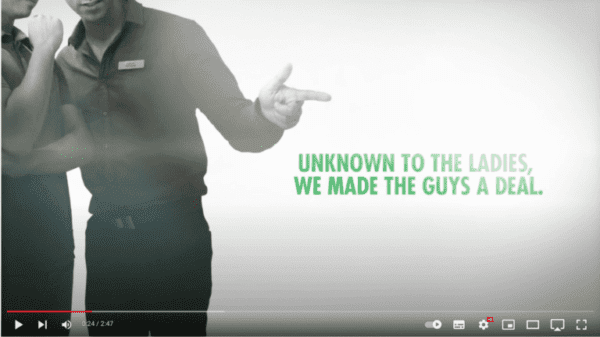
These are the persuasion techniques that they used:
- 0.54 seconds: ‘What do you think?’ – Pull technique with confident body language.
- 0.58 seconds: ‘My butt’ – Irritator.
- 1.00 seconds: ‘They just spoke to me’ – He is using the trust model. All the parts. Asking his partner to trust him based on their long relationship. Relationship technique.
- 1.09 seconds: ‘Get a cheaper one’ – He’s brave! We don’t have a technique for silly bravery.
- 1.22 seconds: ‘We have to buy these now’ – Time pressure technique.
- 1.24 seconds: ‘It;’s plastic. It’s durable’. – Logic.
- 1.27 seconds: ‘Investment. Like those designer handbags’ – Guilt.
- 1.31 seconds: ‘You won’t have to worry about the dogs chewing on them’ – Logic.
- 1.33 seconds: ‘The sculptural piece’ – Vision.
- 1.41 seconds: ‘This will give our home an industrial feel’ – Enthusiasm.
- 1.51 seconds: Trust me on this’ – Using the trust model leveraging their relationship. Relationship technique.
The relationship persuasion technique worked and was probably the only tool that would have worked because logic, pressure, and guilt were not enough by themselves to persuade her. This ask is in the bottom right of the situational persuasion matrix, see below. A big ask of someone you know well. Normally, two, or more techniques would need to be used, but when you pull out the Royal Flush technique it’s a winner.
Use it rarely.
Negative Persuasion Techniques – Those that I’d Recommend Not Using
You can get people to do what you want through positive means, like saying please or painting a vision with words. You can also get them to do what you want with negative persuasion techniques. I’d recommend not using these because although they may work they will harm your relationship long term.
The 9 negative persuasion tools are:
- 4. Self Orientation – Talk about yourself a lot and watch people be dissuaded
- 33. Guilt – ‘The kids would love to see the tree up’
- 34. Escalation – ‘Get me the manager’
- 35. Bullying – Doing what someone wants because you feel intimidated
- 36. Threat – ‘If you don’t do x, I will do y’
- 44. Tell – ‘Go and tidy your bedroom
- 73. Financial – Getting what you want because you paid for it
- 75. Plea – A plea for someone to do something can be very effective
- 76. Wearing people down – You’ve asked. You’ve pleaded. And you keep on trying
That said, in the right situation, you might use wearing people down, telling, or escalating (The latter, in a restaurant or calling a call centre). Just be aware that they are the negative side of persuasion and more of a blunt tool than a sharp tool.
Introducing the Situational Persuasion Model
No good soft skills insight is complete without a model to use. Think situational leadership…drum roll…I introduce the ‘Situational Persuasion’ model. I’m sure Ken Blanchard won’t mind some pinching with pride.
You saw it here first…’Situational Persuasion’.
How Does the Situational Persuasion Model work?
Two axes; 1. How big is the ask? And 2. How well do you know them?
For example, if it is a family member and you are asking for a cup of tea, the ‘Please’ persuasion technique is probably enough. It is in the bottom left box of the model. However, if it is a colleague that you have never met and you are asking them to help big time on a project, then you’ll probably need a combination of 3 persuasion techniques. For example, ‘Please can you help me with the ABC project because I am told that you are the best woman for the job and that together we can share the results at the SLT meeting next week’. Persuasion techniques used: Please, compliment, and vision. This is in the top right box of the situational persuasion model.
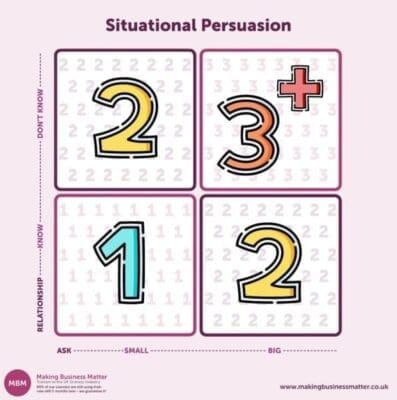
Whilst some techniques of persuasion can be extremely powerful on their own, like vision – think Martin Luther King, most people aren’t effective enough with a single approach to persuade. Therefore, the model suggests that you either need, 1, 2, or 3 persuasion techniques combined in order to get what you want.
The Advanced Section! Combining Persuasion Techniques
We already do this. We just don’t realise it. By realising it, we could then do it better and get more people to do what we want.
You may have heard of the 4 levels of learning. As you were reading this article you were at level 2: Conscious Incompetence (Yellow) – ‘I know I do this. Some good, some not soo good. Oh, that’s how it works’. I’d like to get you to level 3: Conscious Competence (Green) – ‘Oh, that article said that I used 7 techniques and that number 42 was a good one to use. I’ll try that. Hmmm…when Sue asked me to do that the other day Sue used 56 and 70. Interesting’.
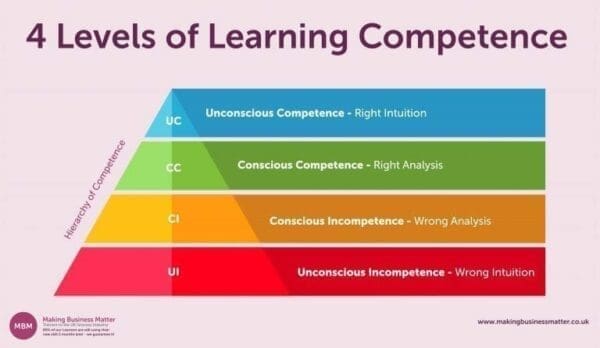
Being able to identify what you use when you persuade people and what they use is a good step in learning how to persuade more effectively. Then, understanding the situational persuasion model will take you a further step forward. Knowing that you need to combine persuasion tools in order to get what you want from the biggest asks is the final step.
Combination Persuasion Techniques’ Examples
To persuade a person that you do not know to do something big will require you to combine 3 persuasion tools (Top right of our model).
For Example:
Please can you help me with the ABC project because I am told that you are the best woman for the job and that together we can share the results at the SLT meeting next week.
Techniques used: Please + complement + vision.
Another Example:
I really believe that we could achieve the +7% sales target because….we can…and, well, do you think we can?
Techniques used: Because + pause + pull
You probably wouldn’t use a combination of 3 techniques in one sentence, or one paragraph. More, it would be in a conversation. For example here are 5 techniques employed in one persuasion:
Sporty Spice: ‘Can you help me with the seating plan for the golf day dinner?’.
Technique #1: Ask.
Ginger Spice: ‘I am just too busy’.
Sporty Spice: ‘I know you are up against it and they shouldn’t have piled all that work onto you’.
Technique #2: Empathy.
Ginger Spice: ‘I really am up against it and now having to work the weekend too’.
Sporty Spice: ‘I’ll be your best friend if you help me’.
Technique #3: Cheeky encouragement.
Ginger Spice: ‘Sorry, I just can’t’.
Sporty Spice: ‘If you can help me with this, then I’ll help you analyse the data you need for that work’.
Technique #4: If you, then I.
Ginger Spice: ‘You don’t have time and nor do I. I must focus on this’.
Sporty Spice: ‘Well, it’s up to you, of course. I was just trying to help us both out’.
Technique: #5: Free decision.
Ginger Spice: ‘Oh, go on then. You pain in my behind. Where do we start?’.
The challenge with becoming a powerful persuader is twofold; 1. Expanding your toolbox with one, two or 3 more techniques, and then, 2. selecting the right tools for the job, according to the situational persuasion model.
Now Time for an Exercise
Just like a carpenter using the right tools for the job. Soft skills is about you having your tools, making sure they are sharp and selecting the right ones to get people to do what you want so that you get others to do much more of what you want.
Which techniques did I use in the sentences above – ‘Just like…productive at work’.
…
…
…
I used:
- Metaphor – carpenter.
- Three points (A build on the 3 words technique by using 3 points) – tools, sharp, and select.
- Vision – ‘much more productive at work’.
What combination of 3 techniques would you use to get someone to do what you want? Think of an example of what you have done to persuade someone and now what you would do if you had your time again.
HBDI with Persuasion Techniques

As you may know, HBDI is about understanding how we and others prefer to think. In either Facts, Future, Form, or Feelings. By doing so, we can then ‘speak their language’.
Certain persuasion techniques lend themselves better to each quadrant. Here are 3 persuasion techniques that fall into each of the 4 categories:
Blue – Facts
- Logic
- Financial
- Expert
Yellow – Future
- Metaphor
- Vision
- Framing
Green – Form
- Plan
- Reliable
- Necessity
Red – Feelings
- Empathy
- Belief
- Plea
If you can identify which HBDI colour your persuadee is, and then select the persuasive tool that fits in that category you might get a better hearing about what you are wanting them to do.
For example, the most obvious is probably logic with the Blues because they are fact-based and logic will appeal to them. Another example is using empathy with the Reds because they are feelings people and this will appeal directly to their hearts.
Making Persuasive Techniques Stick
The biggest waste of time is to read this article, love it, and do nothing because you’ll never become a powerhouse of persuasion. Instead, here are some ways you can make the knowledge stick. More importantly, start improving your ability to persuade.
7 Options
- 1: Pick one tool above that you do not currently use and start using it. Which one will it be?
- 2: Start becoming interested in persuasion. Observe people persuading and try to identify the technique. You don’t need to know the number or even what it’s called. Just identify a technique and call it something you will remember. Then repeat.
- 3: Challenge yourself now. Yes, now. Do this exercise below by answering which 3 techniques you would use for each scenario:
- A. You are taking rubbish to the dump. A jobsworth says to you, as you pull up in the car, you’ll need to pay for rubble mate. It’s our policy.
- B. A colleague at work replies to your request, ‘I can’t go to the manager’s meeting on Friday for you because I am up against it’.
- C. At parent’s evening the teacher won’t do as you asked, allowing little Timmy to sit at the front of the class so that the teacher can keep an eye on him’.
- 4: Share this article with someone by sending them the link and saying that the one you really like is number x.
- 5: Send this article to your team, saying that you’d love to spend 20 minutes on this as a team to hear everyone’s thoughts.
- 6: Email me at das@makingbusinessmatter.co.uk and tell me one that I have missed.
- 7: Print the article by going to ‘File’, then ‘Export as PDF’, and then print. Read it when you have a little more time. Grab a highlighter as you do.
Concluding My Thoughts on Getting People to Do What You Want
I am on a journey with this. The research, observation of people and soul-searching of what we actually do each day has been fascinating. I am learning. Learning that there are so many more techniques than a search of Google suggests. In the world of soft skills, this skill feels really important.
There are three priorities for those wanting to build their soft skills and it looks like this – Getting the most.
- The most from your time – Time management skills.
- The most from your people – Leadership skills and people management skills.
- The most from your interactions – Persuasion and influencing skills. Followed by sales, presenting and negotiation, depending on which job you do.
We have to teach our kids something unique, so that a machine can never catch up with us: values, believing, independent thinking, teamwork, care for others – the soft skills – sports, music, painting, arts, to make sure humans are different from machines. Jack Ma, Chairman of Alibaba.
Bonus – Don’t Ask If You Don’t Want the Answer…
In this post, I would like you to consider something you say most days that gets you the opposite of what you want. Using the question – Why Not?
‘Why Not Come Out to the Cinema With us Tonight?’
Have you ever heard a friend say, ‘Why not come out to the cinema with us tonight?’. 9 times out of 10, you’ll tell them why not, because of this or that or the other. After all, they did ask you to think ‘Why not…?’ and you answered with several very good reasons why not. Brilliant! They asked and you told them. Yet what they really wanted was for you to go to the cinema and there you are telling them why you won’t. A lose-lose situation.
Friends Aren’t the Only Ones That Ask ‘Why Not…?’.
The question is part of our ‘being’. No one questions its use, yet we are always surprised by the results. So entrenched is the question in our culture that companies spend millions getting brilliant copy written and that fatal question still sneaks through missing vital sales.
Even Those Gurus at Facebook Aren’t Aware
As soon as I read this message from Facebook I thought, ‘I haven’t got time, social media won’t work on that business, and stop harassing me’. Instead of encouraging me to post something, the exact opposite happened. I became more resolute as to why I couldn’t post on Facebook and now had 3 very good reasons not to.

Even Marks and Spencer Get it Wrong
After buying some of the famous M&S underwear, they asked on their packaging, ‘Why not try our website?’. My response was, ‘I can’t be bothered, that’s why’.
Be Careful What You Ask For
As the famous phrase goes, from Aesop’s Fables, ‘Be careful what you wish for’. An update on this phrase is, ‘Be careful what you ask for’. If you want your friends to go to the cinema then you are more likely to get them to join you if you ask, ‘Fancy coming to the cinema?’, because if you ask ‘Why not…’, they’ll tell you why not.
Don’t ask that fatal question and get the opposite of what you want.
Get the Book!
This article also comes as a small paperback book or an eBook so that you can take your persuasion toolkit with you wherever you go!

Head over to Amazon and buy the 78 Persuasion Techniques paperback or the eBook today.





